
|

|
|
Home Site Search Contact Us Subscribe
|
|
|
INSIGHT: Bringing Art to the Streets without Breaking the Bank An architect explains how he used innovative materials and a close-knit alliance of stakeholders to provide economical solutions to create an artful amenity for a city's public transit passengers. By Walter Geiger, AIA, FARA February 14, 2012 For those of us who envision architecture as a mode of bringing art to the public, the state of public funding for such projects can be challenging. As cities grapple with tough budget cuts, they find themselves lacking the cash to maintain or restore existing installations, not to mention financing new ones.
Yet amid these circumstances, there’s hope for using architectural art to inspire the imagination and meet practical needs. Designers are getting more creative with innovative materials and small, agile partnerships that provide economical solutions to engage patrons in street environments.
Transforming the Bus-Stop Experience
One of these collaborations recently came to life in Orlando, Florida, with the installation of “art shelters” designed to transform four bus stops along the city’s International Drive. Known as the “Cascade Series,” these white, curvilinear structures put art within reach of public transit passengers. This project was the result of a longstanding partnership with Entech Creative Industries, a firm providing custom engineering and fabrication services.
In a visit to Entech’s fabrication facility, I became inspired by the potential of composite materials to take on organic shapes. Entech has used composites in a wide variety of Orlando theme park projects, including The Simpsons Ride at Universal Studios.
Not long afterward, I met an official of LYNX (Central Florida Regional Transportation Authority), which operates a network of bus lines and approximately 4,000 bus stops throughout Central Florida. She expressed interest in creating a public art collection that would serve a functional purpose – sheltering waiting passengers. After a series of discussions, Entech CEO John Marhoefer, PE, and I embarked on a research process to pave the way for this project.
I studied the surrounding environment to create a “visual language” that artfully contrasts with the lush landscaping and the architecture of luxury hotels and a convention center located along that section of International Drive. This resulted in a series of fluid-looking structures that complement the natural flora and the rectilinear faces of adjacent buildings. I chose white because it works to differentiate the forms in a variety of rural, suburban, and urban bus stop locations.
Then, John and I considered an intriguing question: Could we re-imagine the traditional form of a shelter, bypassing standard construction techniques in favor of a more expressive, free-flowing shape? In pursuit of an answer, Entech launched an extensive prototype process, resulting in a material – the Entech EG 21 Series Formable Composite Panel – that is both malleable and strong enough to sustain a Category 3 hurricane. We presented several models to LYNX – and, after obtaining their approval, further refined these forms and laser-scanned 24-inch renderings of them to create a CAD model. Next, Entech cut life-size patterns using a 5-axis CNC (computer numeric control) mill to create the mold that was used to form the panels. The panels were then anchored into a reinforced concrete slab base to create the structures, which are approximately 15 feet tall and feature a honeycomb interior sandwiched by layers of fiberglass skin.
Bringing Together Stakeholders
Though we were confident in the structural and artistic integrity of the pieces, this project was like any other in the realm of civic structures – we needed to present and defend it to constituents. Our intention was to bring together a diverse group of stakeholders – architects, city planners, LYNX, the arts community, and public transit passengers. Early in the process, we were fortunate to gain the support of LYNX and local government officials who saw the value of bringing art to the streets. Still, this was the first time that LYNX had ever purchased art for bus shelters, having previously tendered public contracts for the design and construction of standard pieces.
Our challenge was to work within a very transparent procurement system while preserving the nature of copyrighted, art-specific materials. As part of that system, we had to pass the litmus test of delivering these shelters for the price of conventional post-and-beam shelters. Composites proved to be key to meeting this price point since the price of casting such a mold with composite material is far lower than using concrete or steel.
Additionally, the city’s building department has no written code for a civil structure made of composites. As a result, Entech engineers designed and conducted structural testing for these materials. Using this data, we were able to quantify how our structures would withstand pressure when compared with other materials. The results were clear and the structures were approved by the building department. The full process – from research through final installation – took about three years.
Looking to the Future
Having successfully completed the “Cascades Series” installation, I believe there are several takeaways for the future of architectural art.
First, there are a number of applications for both composite technology and the type of close-knit, locally based alliance that brought this project to fruition. One of the first that comes to mind is transportation hubs – particularly commuter and light rail systems, where waiting passengers are a captive audience for art installations. Additionally, urban and suburban parks could incorporate similar structures along physical fitness courses or as resting places for walkers, joggers, and cyclists.
To accomplish public art projects within budget, it’s crucial to assemble a team in which all members balance one another’s strengths. During the “Cascades Series” project, Entech’s can-do approach and feasibility expertise enabled us to refine our concept and tackle challenges that arose along the way. Based in Orlando, Entech also had a vested interest in the project’s success.
Over time, we will likely see composites used in larger structures – perhaps even the shells of entire buildings – as the industry grows in influence. For now, given the budget restrictions many municipalities are facing, smaller-scale applications of composites pose a promising future for public art initiatives. As commodity prices for metals continue to rise, adopting creative approaches to materials will be imperative to achieve the economical results demanded by the public sector.
Throughout his architecture career, Washington, DC-based Walter Geiger, AIA, FARA, PE, has led diverse teams of industry professionals, including architects, landscape architects, engineers, fabricators, lighting designers, graphic designers, artists, and a wide spectrum of specialty consultants. Complex and challenging projects in the United States, Asia, South America, and the Middle East comprise his portfolio. As a sculptor, Geiger draws inspiration from natural land forms and observations of water, flora, and atmospheric cloud patterns. As in his professional work as an architect, his work as an artist involves creative teams who study and utilize technological innovations and applications to achieve dynamic, free-standing forms.
John Marhoefer, PE, CEO, co-founder, and chief engineer at Entech Creative Industries, has more than 25 years of experience developing special systems for the entertainment and leisure industries. With a professional background in mechanical and structural design, he also possesses broad knowledge and experience in electrical power control and hydraulic systems. Marhoefer earned a BSCE degree from Lehigh University, an MBA from the Crummer School of Business, Rollins College, is a registered professional engineer, and a certified general contractor.
|
(click on pictures to enlarge) 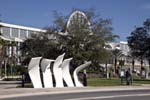 © 2011 Walt Geiger Studios LLC, Raymond Martinot, photographer The “Cascade Series” bus shelters along Orlando’s International Drive 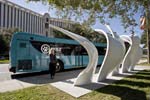 © 2011 Walt Geiger Studios LLC, Raymond Martinot, photographer
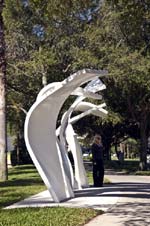 © 2011 Walt Geiger Studios LLC, Raymond Martinot, photographer
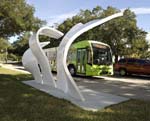 © 2011 Walt Geiger Studios LLC, Raymond Martinot, photographer
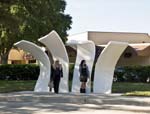 © 2011 Walt Geiger Studios LLC, Raymond Martinot, photographer
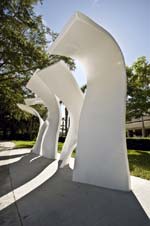 © 2011 Walt Geiger Studios LLC, Raymond Martinot, photographer
|
© 2012 ArchNewsNow.com